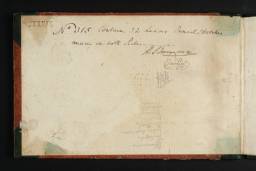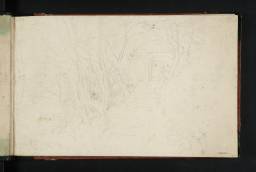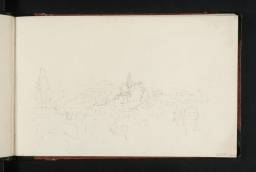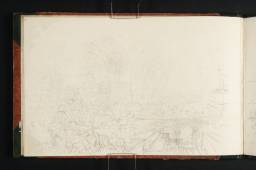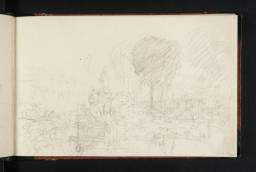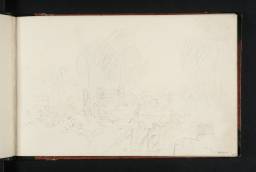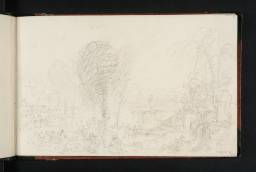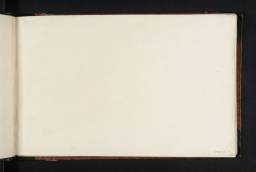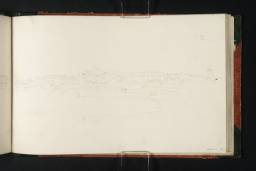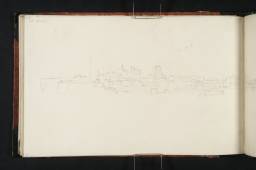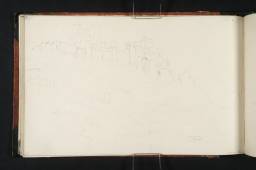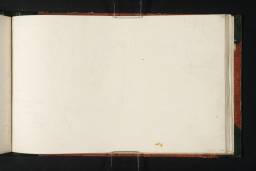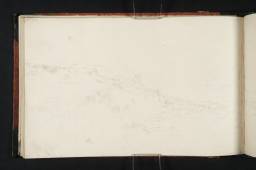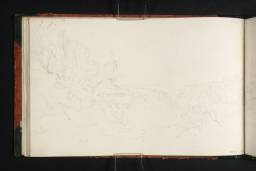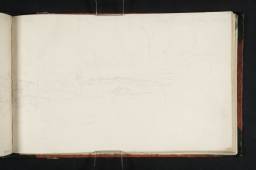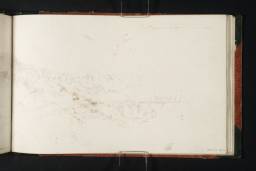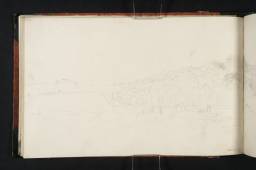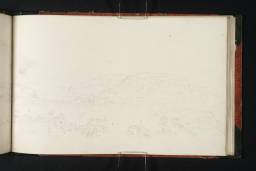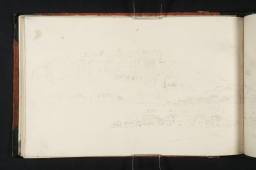Turner Bequest CXXXIX
Sketchbook, bound in boards, with red paper covers and green leather spine and corners
42 leaves of white wove paper
Approximate page size 129 x 205 mm
Watermark ‘J. WHATMAN | 1815’
Endorsed by the Executors of the Turner Bequest in ink ‘No 315 Contains 32 Leaves Pencil Sketches | many on both Sides’ and signed by Henry Scott Trimmer and Charles Turner in ink ‘H.S. Trimmer’ and ‘C Turner’ and in pencil by Charles Lock Eastlake and John Prescott Knight ‘C.L.E.’ and ‘JPK’ inside front cover (D40814). A further endorsement by John Ruskin, ‘315. Hastings’, is recorded by Finberg
Stamped in black ‘CXXXIX’ and blind-stamped with the Turner Bequest monogram inside front cover
42 leaves of white wove paper
Approximate page size 129 x 205 mm
Watermark ‘J. WHATMAN | 1815’
Endorsed by the Executors of the Turner Bequest in ink ‘No 315 Contains 32 Leaves Pencil Sketches | many on both Sides’ and signed by Henry Scott Trimmer and Charles Turner in ink ‘H.S. Trimmer’ and ‘C Turner’ and in pencil by Charles Lock Eastlake and John Prescott Knight ‘C.L.E.’ and ‘JPK’ inside front cover (D40814). A further endorsement by John Ruskin, ‘315. Hastings’, is recorded by Finberg
Stamped in black ‘CXXXIX’ and blind-stamped with the Turner Bequest monogram inside front cover
Accepted by the nation as part of the Turner Bequest 1856
Exhibition history
References
This sketchbook contains a mixture of subjects in Yorkshire, Sussex and Kent. The Yorkshire subjects derive from visits to and work for Walter Fawkes at Farnley Hall in Wharfedale, those in Sussex from visits to John Fuller at Rosehill (now Brightling) Park. Typically of sketchbooks at this period of Turner’s life, projects overlap. Views of Rosehill and the Observatory at Brightling made as the basis of commissioned watercolours are joined by drawings (in Kent as well as Sussex) for subjects in the Cooke brothers’ Picturesque Views on the Southern Coast of England and for the ‘Views at Hastings and its Vicinity’ advertised by William Bernard Cooke in 1822. While at first glance this combination of content makes the book difficult to place, the predominance of Sussex subjects justifies its position with other books used in the county.
The book has attracted a range of dates. Finberg’s was 1815–16, the earliest possible but probably too early in view of the 1815 watermark. However, Finberg also considered views at Rye, Hastings and Margate later than the ‘Fuller and Farnley subjects’, perhaps as late as 1821.1 This was on comparison with others in the Richmond Hill; Hastings to Margate sketchbook (Tate D10409–D10585; D40868; D41539; Turner Bequest CXL) and the Folkestone sketchbook (Tate D17207–D17364; D40685–D40686; Turner Bequest CXCVIII), which is watermarked 1819 and contains a copy of a receipt dated 3 April 1821 (though not, in Finberg’s opinion, in Turner’s writing). The 1974 bicentenary catalogue dates the book to 1816. David Hill, Stanley Warburton and Mary Tussey opt for 1818 tout court, identifying the list of places or subjects written inside the front cover (D40814) with watercolours for the Southern Coast delivered that year. However, some appear in W.B. Cooke’s accounts for 18172 and this could as easily be a to-do list as one of work completed. Noting that the leaves of the book appear to have been numbered in reverse, the same authors suggest that the views of the Farnley estate and Wharfedale at the ‘back’ (or presumed front) could be from 1817 and those at the other end from a year later. Since Turner visited Farnley every year this cannot be confirmed with certainty, and it perhaps assumes a more systematic and chronological use of his sketchbooks than was often the case. (See Technical notes below for further comment on numbering and binding).
That said, reverse numbering would certainly explain why a majority of subjects appear inverted. If the book is read from the ‘back’ they appear the right way up and the sequence of southern counties subjects starts at Brightling and Rosehill, progressing through Battle, Hastings, Winchelsea and Rye, Hythe and Dover to Margate, which makes geographical sense (there is a map of the coast between Winchelsea and Dover inside the back (or front) cover (D40834) and prioritises the work for Fuller. In support of Finberg’s view that Fuller’s subjects were drawn first, Turner’s watercolours The Observatory at Rosehill Park, the Seat of John Fuller, Esq. (currently untraced)3 and Rosehill, Sussex (British Museum, London)4 are usually dated 1816. They show the Observatory and additions to the house, both by Robert Smirke, and complemented earlier, more distant views arising from the first phase of Turner’s work for Fuller in 1810.5
In 1819, The Observatory was engraved for Views in Sussex, and other work for Cooke would have fitted easily around Fuller’s more private commission. Hence, three plates for Southern Coast originate in on-the-spot drawings in this book: of Rye, folios 21 verso–22 (D10369–D10370); Hythe, folios 19 verso–20 (D10365–D10366); and Margate, folios 16 verso–17 (D10360–D10361), also used for a design for The Ports of England. Despite Finberg’s belief that these drawings are later, it is easy to imagine Turner making them on a single trip along the south coast from Hastings to Margate. Turner’s Richmond Hill; Hastings to Margate sketchbook must have seen use at the same time, as Finberg was inclined to think,6 as it contains Turner’s first impression of the view of Hythe from the Ashford road (Tate D10497; Turner Bequest CXL 45a) drawn with more detail here. A clue to the date of such a trip comes from the offshore view of Hastings in the present book, folios 22 verso–23 (D10371– D10372), as this was used for the dramatic watercolour Hastings from the Sea signed and dated 1818 (British Museum, London),7 which Cooke later directed towards a proposed sequel to Views in Sussex, ‘Views at Hastings and its Vicinity’. It is also worth mentioning that Turner sailed from Margate to Ostend in 1817.
Sketchbooks in the Turner Bequest principally devoted to Yorkshire or Farnley are discussed in this catalogue by David Hill. In so far as this one overlaps with them, the most direct connection is between views of Farnley Hall and Otley from the West Chevin, especially folios 39 verso–40 verso–41 (D10404–D10406–D10407 and an exact if more detailed counterpart in the Large Farnley sketchbook (Tate D09056; Turner Bequest CXXVIII 40) which was perhaps the culmination of Turner’s investigations of the site. Collectively, these drawings led to a colour beginning (Tate D17177; Turner Bequest CXCVI M) and thence to the watercolour Farnley Hall from above Otley made for Fawkes about 1816–17 (Rijksmuseum, Amsterdam).8 Composition studies for a classical seaport or city with figures on folios 3–6 (D10345–D10350) might be compared to drawings related to The Decline of the Carthaginian Empire (Tate N00499)9 in the Yorkshire 1 sketchbook (Tate D11032, D11034; Turner Bequest CXLIV 101a, 102a) and perhaps also in the Richmond Hill; Hastings to Margate sketchbook (Tate D10555; Turner Bequest CXL 73a), which were used at Farnley and along the South Coast respectively. The other two Farnley subjects in the book, those on folios 1 and 2 (D10343, D10344) dated by Hill, Warburton and Tussey to 1818, served for more watercolours for Fawkes, The Pheasant’s Nest (private collection)10 and The Woodwalk (Fitzwilliam Museum, Cambridge).11
See notes to the Vale of Heathfield and Views in Sussex sketchbook (Tate D10206–D10319; D40863–D40866; Turner Bequest CXXXVII, and Tate D10320–D10324; D10326–D10342; D40296–D40298; Turner Bequest CXXXVIII).
Technical notes
How to cite
David Blayney Brown, ‘Hastings Sketchbook c.1816–18’, sketchbook, May 2011, in David Blayney Brown (ed.), J.M.W. Turner: Sketchbooks, Drawings and Watercolours, Tate Research Publication, December 2012, https://www

